|
|
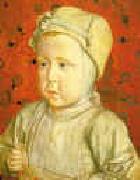 |
Jean Hey
|
|
Flemish Northern Renaissance Painter, active 1480-1500
Until the late 20th century, the name of the painter of the Moulins Triptych was unknown, although art historians identified a number of other works that were evidently by the same hand. The first monograph on the Master of Moulins, written in 1961 by Madeleine Huillet d'Istria, argued that this artist did not actually exist, and that more than 12 different artists were responsible for the corpus of works traditionally ascribed to him. The Master's identity was established after an inscription was found on the reverse of a damaged painting, Christ with Crown of Thorns (1494) in the Royal Museums of Fine Arts of Belgium, Brussels, identifying the artist as Jean Hey, teutonicus and pictor egregius ("the famous painter"), and identifying the patron as Jean Cueillette, who was secretary to the King and an associate of the Bourbon family.Stylistic similarities link this painting to the works attributed to the Master of Moulins. The Master of Moulins appears to have been the court painter for the Bourbons, and from a surviving account for 1502-03, it is clear that the court painter's name was Jean; other candidates once considered plausible, such as Jean Perreal and Jean Prevost, have proven untenable in the light of subsequent research. The term "Teutonicus", or "German" included Flemings at this date. |
|
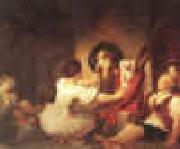 |
Jean Honore Fragonard
|
|
1732-1806
French
Jean Honore Fragonard Locations
French painter. He studied with François Boucher in Paris c. 1749. He subsequently won a Prix de Rome, and while in Italy (1756 ?C 61) he traveled extensively and executed many sketches of the countryside, especially the gardens at the Villa d Este at Tivoli, and developed a great admiration for the work of Giovanni Battista Tiepolo. In 1765 his large historical painting Coresus Sacrifices Himself to Save Callirhoë was purchased for Louis XV and won Fragonard election to the French Royal Academy. He soon abandoned this style to concentrate on landscapes in the manner of Jacob van Ruisdael, portraits, and the decorative, erotic outdoor party scenes for which he became famous (e.g., The Swing, c. 1766). The gentle hedonism of such party scenes epitomized the Rococo style. Although the greater part of his active life was passed during the Neoclassical period, he continued to paint in a Rococo idiom until shortly before the French Revolution, when he lost his patrons and livelihood.
|
|
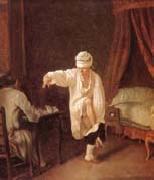 |
jean Huber
|
|
Swiss Painter (b. 1721, Geneve, d. 1786, Bellevue) ,
Geneva1721-1786
Geneva1721-1786,Silhouettist, painter, draughtsman and printmaker. His paternal ancestors were patrician Genevese merchant bankers. As a young man he soldiered at Kassel in Germany and in Italy, where he fought for Savoy in the War of the Austrian Succession (1740-48). In 1752 he was elected to Geneva's Council of Two Hundred and served his native city as a magistrate. He had no formal artistic training, but from his youth he clipped out of paper or cards freehand profiles of a kind that later came to be called silhouettes. |
|
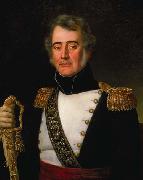 |
Jean joseph Taillasson
|
|
French Painter , Bordeaux 1745-1809 Paris
was a French history painter and portraitist, draftsman and art critic, who matured his talent in the Paris ateliers of Joseph-Marie Vien (from 1764) and Nicolas Bernard L??pici?? and, having won third place in the Prix de Rome competition, 1769, spent four years, 1773-77, in Italy. At his return to Paris he set an early example of neoclassicism. His Observations sur quelques grands peintres, (Paris, Duminil-Lesueur) 1807, offered anti-academic advice somewhat at variance with his own manner |
|
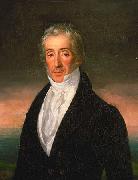 |
Jean Joseph Vaudechamp
|
|
(1790 - 1866) was a French painter born in Rambervillers, Vosges. He was a pupil of Anne-Louis Girodet de Roussy-Trioson. The market in Paris was competitive, so in the winter of 1831 - 32, he went to try his fortunes in New Orleans, Louisiana. The Louisiana Creole people identified with French culture and selected Vaudechamp to paint portraits for them. Over the next ten years he spent winters in New Orleans, and was a leading portrait painter in the region. He died at Neuilly-sur-Seine in 1866.
|
|
|
|
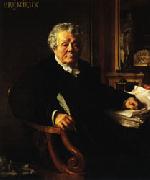 |
Jean Lecomte Du Nouy
|
|
French Painter and Sculptor, 1842-1923,was an orientalist French painter and sculptor. He was Charles Gleyre's and Jean-Leon G??rome's pupil. A Paris street was named after him in 1932. |
|
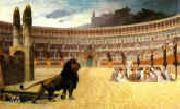 |
Jean Leon Gerome
|
|
French
1824-1904
Jean Leon Gerome Galleries
French painter, sculptor, and teacher. Son of a goldsmith, he studied in Paris and painted melodramatic and often erotic historical and mythological compositions, excelling as a draftsman in the linear style of Jean-Auguste-Dominique Ingres. His best-known works are scenes inspired by several visits to Egypt. In his later years he produced mostly sculpture. He exerted much influence as a teacher at the Ecole des Beaux-Arts; his pupils included Odilon Redon and Thomas Eakins. A staunch defender of the academic tradition, he tried in 1893 to block the government acceptance of the Impressionist works bequeathed by Gustave Caillebotte.
|
|
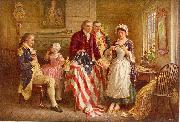 |
Jean Leon Gerome Ferris
|
|
(August 18, 1863 - March 18, 1930) was an American painter best known for his series of 78 scenes from American history, entitled The Pageant of a Nation, the largest series of American historical paintings by a single artist.
He was born in Philadelphia, Pennsylvania, the son of Stephen James Ferris, a portrait painter and a devotee of Jean-L??on G??rôme (after whom he was named) and Mariano Fortuny.He grew up around art, having been trained by his father and having two acclaimed painters, Edward Moran and Thomas Moran, as uncles.
Ferris enrolled in the Pennsylvania Academy of the Fine Arts in 1879 and trained further at the Acad??mie Julian beginning in 1883 under William-Adolphe Bouguereau.He also met his namesake G??rôme, who greatly influenced Ferris's decision to paint scenes from American history. As Ferris wrote in his unpublished autobiography, "[G??rôme's] axiom was that one would paint best that with which he is most familiar".
However, initially his subjects were Orientalist in nature, that movement having been in vogue when he was young. Some of his material was original, some of it took after Fortuny, but he was skilled enough, despite never having had any experience with Asia. In 1882, he exhibited a painting entitled Feeding the Ibis, which was valued at $600.
By 1895, Ferris had gained a reputation as a historical painter, and he embarked on his dream of creating a series of paintings that told a historical narrative. In 1898 he sold one of these, General Howe's Levee, 1777, but he later regretted it, realizing that such a series could not be complete if the separate paintings could not be kept together. As such, he never sold another one of those, but he did sell the reproduction rights to various publishing companies. This later would have the effect of greatly popularizing his work, as these companies made prints, postcards, calendars and blank-backed trade cards use in advertisements. Laminated cards of these works were still being sold as late as 1984.
The Landing of William PennThe paintings showed idealized portrayals of famous moments from American history, but were often historically inaccurate. The Landing of William Penn, for example, shows Penn being greeted at New Castle by American Indians who are clothed in the tradition of tribes from the Great Plains. In The First Thanksgiving 1621, the black outfits the Pilgrims are shown wearing are wrong, and the Wampanoag did not wear feathered war bonnets, nor would they have been sitting on the ground.
The complete series was shown at Independence Hall in Philadelphia from 1913 to 1930, then moved next door to Congress Hall. In later years it was shown in a number of locations, including the Smithsonian Institution, before being returned to the Ferris family. |
|
|
|
|
|
|
|
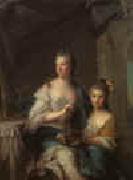 |
Jean Marc Nattier
|
|
1685-1766
French
Jean Marc Nattier Gallery
Brother of Jean-Baptiste Nattier. As well as being taught by his father, he trained with his godfather, Jean Jouvenet, and attended the drawing classes of the Academie Royale, where in 1700 he won the Premier Prix de Dessin. From around 1703 he worked on La Galerie du Palais du Luxembourg. The experience of copying the work of Rubens does not, however, seem to have had a liberating effect on his draughtsmanship, which was described by the 18th-century collector Pierre-Jean Mariette as cold. Nattier was commissioned to make further drawings for engravers in the early part of his career, including those after Hyacinthe Rigaud famous state portrait of Louis XIV (1701; Paris, Louvre) in 1710, which indicates that he had established a reputation while he was still quite young. Although he was offered a place at the Academie de France in Rome on the recommendation of Jouvenet, Nattier preferred to remain in Paris and further his career. In 1717 he nevertheless made a trip to Holland, where he painted portraits of Peter the Great and the Empress Catherine (St Petersburg, Hermitage). The Tsar offered Nattier work at the Russian court, but the artist declined the offer. He remained in Paris for the rest of his life. |
|
 |
jean metzinger
|
|
Jean Metzinger (June 24, 1883 Nantes, France?C November 3, 1956) was a French painter.
Initially he was influenced by Fauvism and Impressionism, but from 1908 he was associated with Cubism. Metzinger was a member of the Section d'Or group of artists. Certain pieces such as At the Cycle-Race track suggest speed and movement, ideas which are linked to the futurist movement.
Together with Albert Gleizes, Metzinger created the first major treatise on Cubism, Du Cubisme, in 1912. In the latter stages of his career, he moved away from cubism towards realism, while still retaining elements of cubist style. |
|
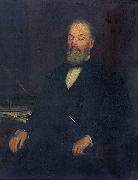 |
Jean Paul Selinger
|
|
Jean Paul Selinger (1850-1909) and Emily Selinger (1848-1927), husband and wife, had summer art studios at the Glen House and the Crawford House. Born in Boston, Jean Paul studied at the Lowell Institute and in 1875 he went to Germany to study at the Munich Academy with Wilhelm Leibl. Upon returning, he opened an art studio in Providence, Rhode Island, and married Emily McGary, also an artist. The Selingers had a studio in Boston and a summer art studio at the Glen House, Pinkham Notch in the 1880s. In 1894 the Selingers moved into the former studio of Frank H. Shapleigh at the Crawford House. In August 1894 the Selingers accepted an invitation to serve on the board of judges for a North Conway Coaching Parade Committee. Jean Paul painted numerous portraits, still-life paintings, and White Mountain landscapes. Emily painted both watercolors and oils of local flora.
Jean Paul was a member of the Boston Art Club. He exhibited at the National Academy of Design in 1880 and the Paint and Clay Club in Boston in 1889. |
|
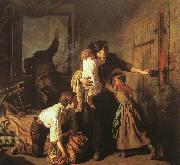 |
Jean Pierre Alexandre Antigna
|
|
1817-1878
French
Jean Pierre Alexandre Antigna Gallery
French painter. He was taught at the school of drawing in Orl?ans by a local painter, Fran?ois Salmon (1781-1855). On 9 October 1837 he entered the Ecole des Beaux-Arts in Paris, first in the atelier of Sebastien Norblin de la Gourdaine (1796-1884). A year later he became a pupil of Paul Delaroche, from whom he acquired his understanding of dramatic composition. |
|
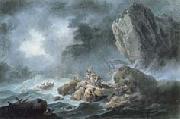 |
Jean Pillement
|
|
French Rococo Era Painter ,
1728-1808
was a painter and designer, known for his exquisite and delicate landscapes, but whose importance lies primarily in the engravings done after his drawings and their influence in spreading the Rococo style, and particularly the taste for chinoiserie, throughout Europe. Pillement, born in Lyon, had an unusually cosmopolitan career. He moved from Paris, working for the Gobelin factory to Lisbon, where the need to rebuild after the disastrous 1755 earthquake had created many opportunities. There he was working in Queluz (Sintra) and for the Dutch consul, the known art collector Jan Gildemeester. Pillement spend eight years in England, fully exploiting the English taste for landscapes. There the paintings by Nicolaes Berchem inspired him. Pillement came acquainted with David Garrick, a famous actor, and his Austrian wife Eva Maria Weigel, collectors of his work in England. Pillement went to Vienna and in 1765 he went to Warsaw, decorating the Royal Castle in Warsaw and the Ujazdowski Castle, his largest project, commissioned by Stanisaw August Poniatowski. He also worked in Saint Petersburg, the Piedmont, Milan, Rome, Venice. Pillement travelled to Paris to work for Marie Antoinette in the Petit Trianon. |
|
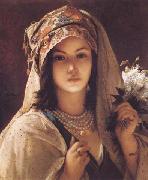 |
Jean Portaels
|
|
Vilvorde, 1818 - Schaerbeek, 1895
was a Belgian orientalist painter and director of the Academy of Brussels. His father, a rich brewer, sent him to study at the Brussels Academy, whose Director, François Navez, took him on soon after in his own workshop. About 1841 Portaels went to Paris, where he was well received by Paul Delaroche. After his return to Belgium, he won the Grand Prix de Rome in 1842. He then travelled through Italy, Greece, Morocco, Algeria, Egypt, the Lebanon, Judaea, Spain, Hungary and Norway. On his return to Belgium in 1847 Portaels succeeded H. Vanderhaert as Director of the Academy in Ghent. In 1849 he married the daughter of his first teacher, Navez, and in 1850 he settled in Brussels; but when he did not get the post of Director of the Brussels academy, and wished, nevertheless, to carry on teaching as his father-in-law had done, he opened a private studio-school, which became one of great significance in the development of Belgian art. Once more he went on his travels, spending time in Morocco; he returned to Brussels in 1874, and in 1878 became Director of the Academy which had so long been the object of his ambition. Portaels was an extremely prolific artist. Huge oil paintings adorning the walls of St Jacques-sur-Caudenberg; biblical scenes, such as The Daughter of Sion Reviled, The Death of Judas, The Magi travelling to Bethlehem, Judiths Prayer, and The Drought in Judaea; genre pictures, such as A Box in the Theatre at Budapest , portraits of officials and of high society, Oriental scenes and, above all, pictures of exotic female figures and exotic life. "His work is usually marked by an easy grace, which he perhaps uses to excess", wrote Theophile Gautier. But his pleasing and abundant productions as a painter do not constitute Portaels' crowning merit. |
|
 |
Jean Pucelle
|
|
French Gothic Era Manuscript Illuminator, ca.1300-1355
was a Parisian Gothic-era manuscript illuminator, active between 1320 and 1350. His style is characterized by delicate figures rendered in grisaille, accented with touches of color. Pucelle's most famous work is the The Hours of Jeanne d'Evreux, c. 1324-1328. |
|
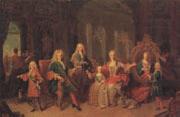 |
Jean Ranc
|
|
French portraits painter, 1674-1735
French painter, active also in Spain. His father was the painter Antoine Ranc (1634-1716), under whom he must have trained. From 1697 he lived in Paris, where he continued his apprenticeship in Hyacinthe Rigaud's studio. After working for some years as Rigaud's assistant, he joined the Academie Royale de Peinture et de Sculpture in Paris in 1703 and reached the rank of academician as a portrait painter in 1707. As Rigaud's protege he worked for the French court, painting portraits of Louis XV (1718; Versailles, Cheteau) and almost certainly other members of the royal family as well as of the aristocracy. He also painted some allegorical and mythological works, such as Vertumnus and Pomona |
|
 |
Jean Raoux
|
|
French Painter, 1677-1734, French painter. He trained first in Montpellier with Antoine Ranc (1634-1716), in whose studio he completed his early painting Ariadne on Naxos (1701; Montpellier, Mus. Fabre). He subsequently moved to the Paris studio of Bon Boullogne and in 1704 won the Prix de Rome with David Slaying Goliath (untraced). He completed his education at the Acad?mie de France in Rome and also spent time in Florence and Padua. For the Cathedral at Padua he executed an Annunciation and a Visitation (both in situ). In 1707-9 Raoux was in Venice, where he made contact with his future patron Philippe de Vendeme (1665-1727), Grand Prior of the Order of the Knights of Malta. From 1714 he lodged in the Grand Prior's Paris residence, the Temple, a privilege that was renewed in 1719 by Vendeme's successor Jean-Philippe, |
|
 |
Jean Restout
|
|
French Neoclassical Painter, 1692-1768,was a French Neoclassical painter. Jean Restout was born in Rouen, the son of Jean Restout, the first of that name, and of Marie M. Jouvenet, sister and pupil of the then well-known Jean Jouvenet. In 1717, the Royal Academy having elected him a member on his work for the Grand Prix, he remained in Paris, instead of proceeding to Italy, exhibited at all the salons, and filled successively every post of academical distinction. His works, chiefly altar-pieces (Louvre Museum), ceilings and designs for Gobelin tapestries, were engraved by Cochin, Drevet and others; his diploma picture may still be seen at St Cloud. His son, Jean Bernard Restout (1732 - 1797), |
|
|
|
 |
Jean Simeon Chardin
|
|
(2 November 1699 - 6 December 1779) was an 18th-century French painter. He is considered a master of still life, and is also noted for his genre paintings which depict kitchen maids, children, and domestic activities. Carefully balanced composition, soft diffusion of light, and granular impasto characterize his work.
Chardin was born in Paris, the son of a cabinetmaker, and rarely left the city. He lived on the Left Bank near Saint-Sulpice until 1757, when Louis XV granted him a studio and living quarters in the Louvre.
Chardin entered into a marriage contract with Marguerite Saintard in 1723, whom he did not marry until 1731. He served apprenticeships with the history painters Pierre-Jacques Cazes and Noël-Nicolas Coypel, and in 1724 became a master in the Academie de Saint-Luc.
According to one nineteenth-century writer, at a time when it was hard for unknown painters to come to the attention of the Royal Academy, he first found notice by displaying a painting at the "small Corpus Christi" (held eight days after the regular one) on the Place Dauphine (by the Pont Neuf). Van Loo, passing by in 1720, bought it and later assisted the young painter
|
|
|
|
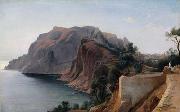 |
Jean-Achille Benouville
|
|
(15 July 1815, Paris - 8 February 1891, Paris) was a French landscape painter of the academic painting school, known for his Italian landscapes. François-Leon Benouville was his younger brother.
|
|
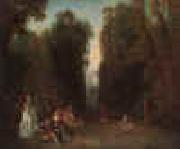 |
Jean-Antoine Watteau
|
|
1684-1721
Antoine Watteau Art Locations
He is best known for his invention of a new genre, the fete galante, a small easel painting in which elegant people are depicted in conversation or music-making in a secluded parkland setting (see under FETE CHAMPETRE). His particular originality lies in the generally restrained nature of the amorous exchanges of his characters, which are conveyed as much by glance as by gesture, and in his mingling of figures in contemporary dress with others in theatrical costume, thus blurring references to both time and place.
Watteau work was widely collected during his lifetime and influenced a number of other painters in the decades following his death, especially in France and England. His drawings were particularly admired. Documented facts about Watteau life are notoriously few, though several friends wrote about him after his death (see Champion). Of over two hundred paintings generally accepted as his work |
|
 |
Jean-Auguste Dominique Ingres
|
|
French Neoclassical Painter, 1780-1867
was a French Neoclassical painter. Although he considered himself a painter of history in the tradition of Nicolas Poussin and Jacques-Louis David, by the end of his life it was Ingres' portraits, both painted and drawn, that were recognized as his greatest legacy.
A man profoundly respectful of the past, he assumed the role of a guardian of academic orthodoxy against the ascendant Romantic style represented by his nemesis Eug??ne Delacroix. His exemplars, he once explained, were "the great masters which flourished in that century of glorious memory when Raphael set the eternal and incontestable bounds of the sublime in art ... I am thus a conservator of good doctrine, and not an innovator." Nevertheless, modern opinion has tended to regard Ingres and the other Neoclassicists of his era as embodying the Romantic spirit of his time, while his expressive distortions of form and space make him an important precursor of modern art.. |
|
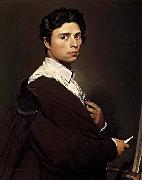 |
Jean-Auguste-Dominique Ingres
|
|
1780-1867
French painter. He was the last grand champion of the French classical tradition of history painting. He was traditionally presented as the opposing force to Delacroix in the early 19th-century confrontation of Neo-classicism and Romanticism, but subsequent assessment has shown the degree to which Ingres, like Neo-classicism, is a manifestation of the Romantic spirit permeating the age. The chronology of Ingres's work is complicated by his obsessive perfectionism, which resulted in multiple versions of a subject and revisions of the original. |
|
 |
Jean-Baptiste Camille Corot
|
|
(July 17, 1796 - February 22, 1875) was a French landscape painter and printmaker in etching. Corot was the leading painter of the Barbizon school of France in the mid-nineteenth century. He is a pivotal figure in landscape painting and his vast output simultaneously references the Neo-Classical tradition and anticipates the plein-air innovations of Impressionism. |
|
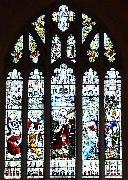 |
Jean-Baptiste Capronnier
|
|
(1814-1891) was a Belgian stained glass painter. Born in Brussels in 1814, he had much to do with the modern revival of glass-painting, and first made his reputation by his study of the old methods of workmanship, and his clever restorations of old examples, and copies made for the Brussels archaeological museum. He carried out windows for various churches in Brussels (including the Église Royale Sainte-Marie), Bruges, Amsterdam and elsewhere, and his work was commissioned also for France, Italy and England. At the Paris Exhibition of 1855 he won the only medal given for glasspainting. He died in Brussels in 1891.
|
|
 |
Jean-Baptiste Carpeaux
|
|
(May 11, 1827 - October 12, 1875) was a French sculptor and painter.
Born in Valenciennes, Nord, son of a mason, his early studies were under François Rude. Carpeaux entered the Ecole des Beaux-Arts in 1844 and won the Prix de Rome in 1854, and moving to Rome to find inspiration, he there studied the works of Michelangelo, Donatello and Verrocchio. Staying in Rome from 1854 to 1861, he obtained a taste for movement and spontaneity, which he joined with the great principles of baroque art. Carpeaux sought real life subjects in the streets and broke with the classical tradition.
While a student in Rome, Carpeaux submitted a plaster version of Pe - heur napolitain e la coquille, the Neapolitan Fisherboy, to the French Academy. He carved the marble version several years later, showing it in the Salon exhibition of 1863. It was purchased for Napoleon III's empress, Eugenie. The statue of the young smiling boy was very popular, and Carpeaux created a number of reproductions and variations in marble and bronze. There is a copy, for instance, in the Samuel H. Kress Collection in the National Gallery of Art in Washington D.C.. Some years later, he carved the Girl with a Shell, a very similar study.
In 1861 he made a bust of Princess Mathilde, and this later brought him several commissions from Napoleon III.
|
|
 |
Jean-Baptiste Corot
|
|
1796-1875
was a French landscape painter and printmaker in etching. Corot was the leading painter of the Barbizon school of France in the mid-nineteenth century. He is a pivotal figure in landscape painting and his vast output simultaneously references the Neo-Classical tradition and anticipates the plein-air innovations of Impressionism. Camille Corot was born in Paris in 1796, in a house at 125 Rue du Bac, now demolished. His family were bourgeois people his father was a wigmaker and his mother a milliner and unlike the experience of some of his artistic colleagues, throughout his life he never felt the want of money, as his parents made good investments and ran their businesses well. After his parents married, they bought the millinery shop where she had worked and he gave up his career as a wigmaker to run the business side of the shop. The store was a famous destination for fashionable Parisians and earned the family an excellent income. Corot was the middle of three children born to the family, who lived above their shop during those years. Corot received a scholarship to study in Rouen, but left after having scholastic difficulties and entered a boarding school. He was not a brilliant student, and throughout his entire school career he did not get a single nomination for a prize, not even for the drawing classes. Unlike many masters who demonstrated early talent and inclinations toward art, before 1815 Corot showed no such interest. During those years he lived with the Sennegon family, whose patriarch was a friend of Corot's father and who spent much time with young Corot on nature walks. It was in this region that Corot made his first paintings after nature. At nineteen, Corot was a big child, shy and awkward. He blushed when spoken to. Before the beautiful ladies who frequented his mother's salon, he was embarrassed and fled like a wild thing Emotionally, he was an affectionate and well-behaved son, who adored his mother and trembled when his father spoke. When Corot's parents moved into a new residence in 1817, the twenty-one year old Corot moved into the dormer-windowed room on the third floor, which became his first studio as well. With his father's help he apprenticed to a draper, but he hated commercial life and despised what he called "business tricks", yet he faithfully remained in the trade until he was 26, when his father consented to his adopting the profession of art. Later Corot stated, I told my father that business and I were simply incompatible, and that I was getting a divorce. The business experience proved beneficial, however, by helping him develop an aesthetic sense through his exposure to the colors and textures of the fabrics. Perhaps out of boredom, he turned to oil painting around 1821 and began immediately with landscapes |
|
 |
Jean-Baptiste Deshays
|
|
French Baroque Era Painter, 1729-1765
was a French painter of religious and mythological subjects.His first training was under his father, the minor Rouen painter Jean-Dominique Deshays, he then spent a little time under Jean-Baptiste Descamps at his Ecole Gratuite de Dessin. He spent time in Hyacinthe Collin de Vermont's Paris studio from around 1740 to 1749 and Jean Restout II's from late 1749 to 1751. Both these had been pupils of Jean Jouvenet, and painted in the Grand Style of French history painting, a style Deshays adopted as his own. While he was in Restout's studio, Deshays entered the Prix de Rome competition, winning second prize in 1750 with His 1750 Laban Giving his Daughter in Marriage to Jacob won the second prize in the Grand Prix de Rome, and his 1751 Job on the Dung-hill the first prize. Deshays served the compulsory three years training at the Ecole des Eleves Prot??g??s (where he learnt from Carle van Loo, its director, and attracted some religious commissions, including two vast canvases, a Visitation and an Annunciation, for the monastery of the Visitation at Rouen), before going to Rome. |
|
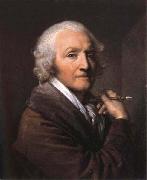 |
Jean-Baptiste Greuze
|
|
French Rococo Era Painter, 1725-1805
French painter and draughtsman. He was named an associate member of the Academie Royale de Peinture et de Sculpture, Paris, in 1755 on the strength of a group of paintings that included genre scenes, portraits and studies of expressive heads (tetes d'expression). These remained the essential subjects of his art for the next 50 years, except for a brief, concentrated and unsuccessful experiment with history painting in the late 1760s, which was to affect his later genre painting deeply. Though his art has often been compared with that of Jean-Simeon Chardin in particular and interpreted within the context of NEO-CLASSICISM in general, it stands so strikingly apart from the currents of its time that Greuze's accomplishments are best described, as they often were by the artist's contemporaries, as unique. He was greatly admired by connoisseurs, critics and the general public throughout most of his life. His pictures were in the collections of such noted connoisseurs as Ange-Laurent de La Live de Jully, Claude-Henri Watelet and Etienne-Franeois, Duc de Choiseul. For a long period he was in particular favour with the critic Denis Diderot, who wrote about him in the Salon reviews that he published in Melchior Grimm's privately circulated Correspondance litt?raire. His reputation declined towards the end of his life and through the early part of the 19th century, to be revived after 1850, when 18th-century painting returned to favour, by such critics as Theophile Thore, Arsene Houssaye and, most notably, Edmond and Jules de Goncourt in their book L'Art du dix-huitieme siecle. By the end of the century Greuze's work, especially his many variations on the Head of a Girl, fetched record prices, and his Broken Pitcher (Paris, Louvre) was one of the most popular paintings in the Louvre. |
|
|
|
|
|
 |
Jean-Baptiste Jouvenet
|
|
1644-1717
French
Jean Baptiste Jouvenet Galleries
He came from an artistic family, one of whom Noel Jouvenet may have taught Nicolas Poussin.
He early showed remarkable aptitude for his profession, and, on arriving in Paris, attracted the attention of Le Brun, by whom he was employed at Versailles, and under whose auspices, in 1675, he became a member of the Acad??mie royale, of which he was elected professor in 1681, and one of the four perpetual rectors in 1707. He also worked under Charles de la Fosse in the Invalides and Trianon.
The great mass of works that he executed, chiefly in Paris, many of which, including his celebrated Miraculous Draught of Fishes (engraved by Audran; also Landon, Annales, i. 42), are now in the Louvre, show his fertility in invention and execution, and also that he possessed in a high degree that general dignity of arrangement and style which distinguished the school of Le Brun.
Jouvenet died on the 5 April 1717, having been forced by paralysis during the last four years of his life to work with his left hand. |
|
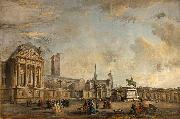 |
Jean-Baptiste Lallemand
|
|
(1716-1803) was a French artist born in Dijon. He was mainly a painter and draftsman of landscapes and genre works. He sometimes signed himself Lallemant or Allemanus.After a stay in Italy, he went to Paris and became a member of the Academie de Saint-Luc. He died in Paris.
The Musee des Beaux-Arts de Dijon owns many of his works, including a drawing and a painting showing the Château de Montmusard. His works also feature in the collections of the Musee Carnavalet and the Cabinet des estampes of the Bibliotheque nationale, both in Paris.
|
|
 |
Jean-Baptiste Le Prince
|
|
French Painter, 1734-1781,French painter, draughtsman and printmaker. Born to a family of ornamental sculptors and gilders, he became famous for creating a new kind of genre picture, based on the direct observation of Russian subjects, and also for perfecting aquatint technique. Sometime around 1750 he became a pupil of Fran?ois Boucher, thanks to the protection of the Mar?chal de Belle-Isle (1684-1761), governor of Metz. Boucher's saturated brushwork, highly finished surfaces and incisive drawing had a decisive impact upon the young artist, as did, perhaps, the diversity of his output. He was also inspired by 17th-century Dutch and Flemish genre and landscape painters. |
|
|
|
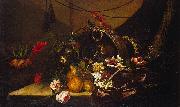 |
Jean-Baptiste Monnoyer
|
|
(12 January 1636 - 20 February 1699) was a Franco-Flemish painter who specialised in flower pieces. He was attached to the Gobelins tapestry workshops and the Beauvais tapestry workshops, too, where he produced cartoons of fruit and flowers for the tapestry-weavers, and at Beauvais was one of three painterswho collaborated to produce cartoons for the suite The Emperor of China.
He was born at Lille, but was in Paris by 1650, where he was documented working on the decors of the Hôtel Lambert. He was taken up by Charles Le Brun for decorative painting at the Château de Marly and at the Grand Dauphin's residence, the Château de Meudon. He was received at the Academie Royale de Peinture et de Sculpture in 1665 with a piece of the genre that he made his specialty, a still life of flowers and fruit combined with objets d'art. His only appearance at the Paris salon was in 1673. |
|
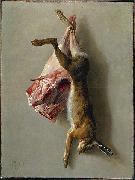 |
Jean-Baptiste Oudry
|
|
(17 March 1686 - 30 April 1755) was a French Rococo painter, engraver, and tapestry designer. He is particularly well known for his naturalistic pictures of animals and his hunt pieces depicting game.
Jean-Baptiste Oudry was born in Paris, the son of Jacques Oudry, a painter and art dealer, and of his wife Nicole Papillon, who belonged to the family of the engraver Jean-Baptiste-Michel Papillon.
His father was a director of the Academie de St-Luc art school, which Oudry joined. At first, Oudry concentrated on portraiture, and he became a pupil and perhaps a collaborator of Nicolas de Largilliere from 1707 to 1712. He graduated at only 22 years of age, on 21 May 1708, at the same time as his two older brothers. The next year, he married Marie-Marguerite Froisse,[1] the daughter of a miroitier (a mirror-maker) to whom he gave lessons in painting.
Oudry became an assistant professor at Academie de Saint-Luc in 1714, and professor on 1 July 1717. He was inducted as a member of the prestigious Academie Royale de Peinture et de Sculpture in 1719, and was engaged as a professor there in 1743.
After producing mainly portraits, Oudry started to produce still life paintings of fruits or animals, aa well as paintings of religious subjects, such as the Nativity, Saint Giles, and the Adoration of the Magi.
|
|
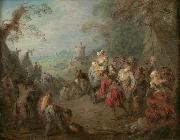 |
Jean-Baptiste Pater
|
|
Jean-Baptiste Pater (December 29, 1695 - July 25, 1736) was a French rococo painter.
Born in Valenciennes, Pater was the son of sculptor Antoine Pater and studied under him before becoming a student of painter Jean-Baptiste Guide. Pater then moved to Paris, briefly becoming a pupil of Antoine Watteau in 1713. Watteau, despite treating Pater badly, had a significant influence on him. However the two quarreled and Pater returned to Valenciennes, where he remained for two years. In 1721, Pater and the dying Watteau reconciled; subsequently Pater became a student of Watteau once again, although only for a month before the latter's death. Pater later claimed to have learnt everything he knew during those few weeks with Watteau. He was accepted into the Academie in 1728, presenting a large military work in the popular Watteau style - La Rejouissance des Soldats (Louvre).[1]
Pater adopted the popular Fete galante subject matter, heavily imitating his teacher Watteau, indeed he directly copied some of his figures. Pater used a traditional Rococo pastel palette. His most characteristic difference in style from other artists of the time surrounded his use of shimmering lines. His most prominent customer was Frederick the Great, who sat for two portraits in the "Turquerie" style: LeSultan au Harem and Le Sultan au Jardin. One of Pater's most renowned works is Landscape with a Cart (Schloss Charlottenburg), which is considered to display a feathery application of paint that anticipates Francesco Guardi. The delicately constructed subject matter and figures subordination to the buildings represent a movement away from fete galante, however this development was cut short by Pater's death in 1736. |
|
 |
Jean-Baptiste Paulin Guerin
|
|
(March 25, 1783 - January 19, 1855), French painter, was born at Toulon, of poor parents.
As a young man, he learned his father's trade of locksmithing, whilst at the same time he followed the classes of the free school of art. Having sold some copies to a local amateur, Guerin started for Paris, where he came under the notice of Vincent, whose counsels were of material service.
In 1810 Guerin made his first appearance at the Salon with some portraits, which had a certain success. In 1812 he exhibited "Cain after the murder of Abel" (formerly in Luxembourg), and, on the return of the Bourbons, was much employed in works of restoration and decoration at Versailles.
|
|
|
|
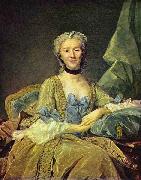 |
Jean-Baptiste Perronneau
|
|
(Paris, c. 1715 - Amsterdam, 19 November 1783) was a French painter who specialized in portraits executed in pastels.
Perronneau began his career as an engraver, apparently studying with Laurent Cars, whose portrait he drew, and working for the entrepreneurial printseller Gabriel Huquier, rue Saint-Jacques, Paris, making his first portraits in oils, and especially in pastels, in the 1740s. His career was much in the shadow of the master of the French pastel portrait, Maurice Quentin de La Tour. In the Salon of 1750, Perronneau exhibited his pastel portrait of Maurice-Quentin de la Tour, but found to his dismay that La Tour was exhibiting his own self portrait, perhaps a malicious confrontation to demonstrate his superiority in the technique.
He made his Salon debut with a pastel portrait in 1746 and received full membership in the Academie Royale de Peinture et de Sculpture in 1753, with portraits of fellow artist Jean-Baptiste Oudry and the sculptor Lambert-Sigisbert Adam, both now at the Louvre Museum. After 1779 he no longer exhibited in the Paris Salons, but the clientele in his portraits reveal how widely he travelled in the provinces of France, with a group of sitters connected with Orleans, but also in Toulouse, Bordeaux, Lyon. Farther afield he may have been in Turin and Rome, and in Spain, Hamburg, Poland, Russia and England.
He died in Amsterdam virtually unknown, according to his biographers. |
|
 |
Jean-Baptiste Pillement
|
|
(Lyon, 24 May 1728 - Lyon, 26 April 1808) was a painter and designer, known for his exquisite and delicate landscapes, but whose importance lies primarily in the engravings done after his drawings, and their influence in spreading the Rococo style and particularly the taste for chinoiserie throughout Europe.
Pillement had an unusually cosmopolitan career. In 1743, at the age of 15, he moved from Lyon to Paris where he was employed as an apprentice designer at the Gobelin factory. In 1745 he left for Spain, where he remained for 5 years. There he found employment in various cities as both a designer and painter. A landscape dated 1748 reveals rustic themes he was to repeat often: sun bathed shepherds leading their goats and sheep to a cascading stream, a water mill, rocky elevations covered in lush vegetation, and the poeticized relics of an ancient bridge. In 1750, at the age of 22, he moved to Lisbon, where he enjoyed continuing success. The lure of travel compelled him to decline an offer to become First Painter to King Joseph of Portugal ?, and in 1754 he left Lisbon for London.
Pillement then spent eight years in England, fully exploiting the English taste for landscapes. There he was inspired by the paintings of, among others, Nicolaes Berchem. During this period he became acquainted with David Garrick, the famous actor, and his Austrian wife Eva Maria Weigel, who became avid collectors of his work. In 1763 Pillement then traveled to Vienna, where he was employed at the Imperial Court of Maria Theresa and Francis I. In 1765 he left Vienna for Warsaw, where his many projects included decorating the Royal Castle in Warsaw and the Ujazdowski Castle, his largest project, commissioned by Stanisław August Poniatowski. He also later worked in Saint Petersburg, the Piedmont, Milan, Rome and Venice. 1768-1780 Pillement again worked in France, where he was employed by Marie Antoinette in the Petit Trianon. 1780-1789 he was once again on the Iberian Peninsula, and in 1789 moved to Pezenas in the Languedoc. In 1800 he returned to Lyon, where he continued to paint while also designing for the silk industry and giving lessons in the Academy founded by Napoleon. |
|
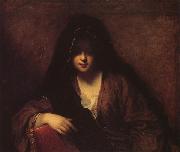 |
Jean-Baptiste Santerre
|
|
French Baroque Era Painter, 1651-1717
The 12th child of a merchant, he was apprenticed to the portrait painter Jean Lemaire before entering the busy studio of the history painter Bon Boullogne. Although he executed some history paintings, he began to specialize in portraiture early in his career. The Portrait of Two Actresses (1699; St Petersburg, Hermitage), clearly influenced by Fran?ois de Troy, shows Santerre's interest in the well-known portrait painters of his time. Nevertheless, he was among the first painters in France to absorb the influence of Rembrandt, as in Young Girl at a Window (Orl?ans, Mus. B.-A.; after Rembrandt, London, Dulwich Pict. Gal.). In such portraits as Girl with a Veil |
|
 |
Jean-Baptiste Van Mour
|
|
17th Century Painters of the Bosporus,was a Flemish-French painter, remembered for his detailed portrayal of life in the Ottoman Empire during the Tulip Era and the rule of Sultan Ahmed III. Van Mour was a native of Valenciennes, a Flemish town that at he time of his birth belonged to the Spanish Netherlands, but since 1678 to France. He studied art in the studio of Jacques-Albert Gerin, and his work attracted the attention of an aristocrat and statesman of the time, Marquis Charles de Ferriol. Van Mour was invited to go to Istanbul when De Ferriol was appointed there as the French Ambassador in 1699. De Ferriol commissioned van Mour to do one hundred portraits of the local people. In 1711 De Ferriol returned to France and van Mour worked for a variety of other diplomats. In the meantime De Ferriol published a series of one hundred engravings (after the paintings) in Recueil de cent estampes representant differentes nations du Levant. The book had a great influence in Western Europe and was published in at least five languages. Painting audiences with the Sultan became van Mour's speciality; he only had to change the setting and a few faces. Van Mour worked with assistants to fulfill all his obligations. In 1725 he was granted the extraordinary title of Peintre Ordinaire du Roy en Levant in recognition of both his and the Levant's importance to the French government. In 1727 the Dutch ambassador Cornelis Calkoen asked Van Mour to record his audience with Sultan Ahmed III on canvas. Van Mour was allowed to enter the palace during these ceremonies accompanying the ambassador and his retinue; therefore, he was familiar with the special protocol that prevailed in the Ottoman court for ambassador's receptions. Calkoen took many paintings of Jean-Baptiste van Mour with him, when he was appointed as ambassador in Dresden for the Dutch Republic. In his will of 1762 the bachelor Calkoen forbade his heirs to sell the paintings, which are now part of the Rijksmuseum collection. |
|
|

